-
Car Reviews
- All reviews
- Midsize SUVs
- Small cars
- Utes
- Small SUVs
- Large SUVs
- Large cars
- Sports SUVs
- Sports cars
- Vans
Latest reviews
- Car News
-
Car Comparisons
Latest comparisons
- Chasing Deals
At long last, the new Stonic gives Kia a super-small SUV to rival the dominant Mazda CX-3. Having had years to study that rival, is the Stonic up to the job?
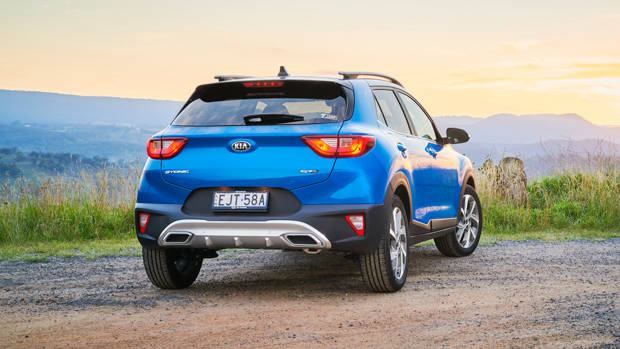
Following up the runaway success of the Kia Seltos is no mean feat.
Having sold just shy of 10,000 units in 2020 – a pandemic-ravaged year that made it much more difficult than most to sell a car – it was clear that Kia really hit the mark with the Seltos, a small SUV that sits at the larger end of that compact category.
The counterpoint to the Seltos has now arrived. Enter the 2021 Kia Stonic: this is a much, well, smaller small SUV. At just 4.14 metres in length, the Stonic is downright diminutive: shorter than a Hyundai Kona, you feel like you can park the new baby Kia crossover in basically any CBD spot you find.
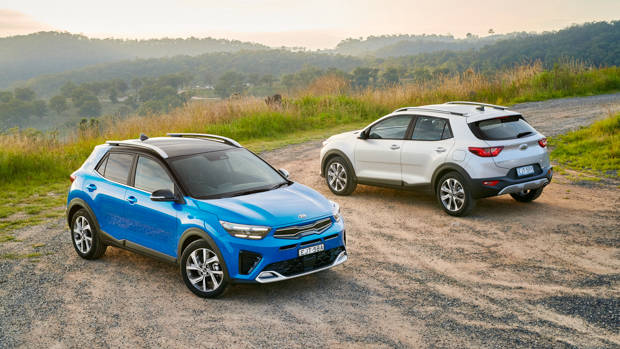
No surprise that the Stonic is so efficient on size: this is a raised and rebodied Kia Rio. The Stonic, which costs $29,990 driveaway in GT-Line form, is also $5,000 more expensive than the Rio it borrows nearly everything from. In fact, Stonic and Rio are so related that Kia has opted to bequeath the latter’s 2017 five-star ANCAP crash rating on it.
Modest dimensions make the Stonic usefully smaller than Enemy Number 1: the Mazda CX-3. Even though it’s now six years old, the dominance of the CX-3 in the ‘light’ SUV segment is hard to understate. In 2020, more than 48 percent of buyers shopping in this space ultimately opted for a CX-3. Mazda pushed nearly 14,000 out the door.
Armed with three variants topped by a remarkably Euro-style turbocharged three-cylinder GT-Line, the Kia Stonic arrives intent on derailing the CX-3’s runaway success.
Kia has had since 2015 to study why the CX-3 has been so effective at convincing Australians that it’s the best light SUV on the market.
Buyer opinions vary, but our past testing of the CX-3 revealed that it’s the Mazda’s bubbling, vivacious handling, zesty engine, strong build quality and decent value for money that have made it such an effective model.
And on most of those attributes, the new Kia Stonic lands blows, even if they don’t quite strike the Mazda down.
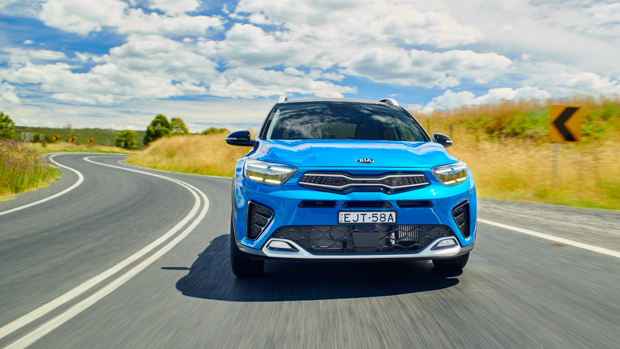
First, there’s the engine. In the GT-Line, it’s a 1.0-litre turbocharged in-line three-cylinder petrol making 74kW of power and 172Nm of torque. Modest outputs for a modestly-sized crossover – usefully, though, the full torque slab is available at just 1,500rpm, making for easy progress.
Or at least progress would be easy if the Stonic’s dual-clutch automatic transmission was calibrated more smoothly. On our test car – which, admittedly, was delivered with about 500km on the odometer – the gearbox lurched and slurred around at low speeds before settling, finally, into crisp and quick shifts on the move.
Still, we’ll take the Stonic GT-Line’s torquey turbo over the base 1.4-litre naturally aspirated engine you get on the base model Stonic S and mid-spec Stonic Sport.
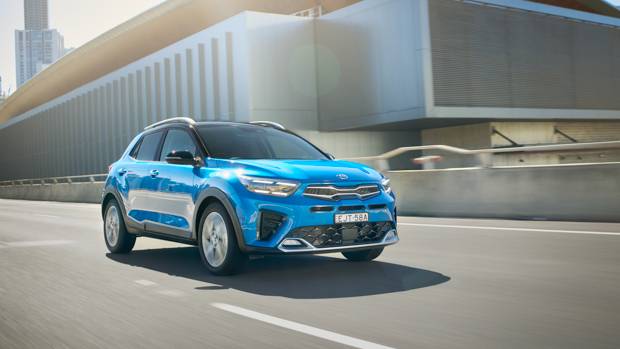
Also armed with 74kW of power, the multipoint-injected 1.4-litre musters only an asthmatic 133Nm of torque. Pretty woeful in 2021. At least there’s a choice of six-speed manual or a six-speed conventional automatic.
It’s not likely either Stonic engine would sway somebody who test drives Mazda’s singing 2.0-litre atmospheric petrol, which conjures up a more scintillating 110kW of power and 195Nm of torque – positively big-block stuff by comparison. And the CX-3 has more fun making all that power.
Certainly, the Kia Stonic’s ride and handling is adept for Australian conditions.
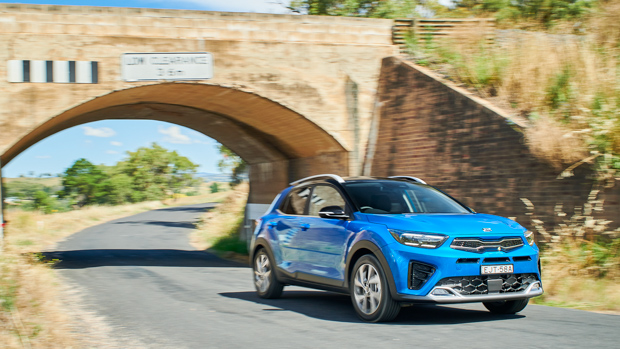
There’s a softer suspension tune on the 1.4-litre models, while the GT-Line enjoys a subtle, well-resolved sports suspension that conveys road feel but without spine-troubling crashiness.
Both tunes were completed by Kia Australia’s crack Melbourne-based team, and their efforts – completed before the pandemic struck hard – are commendable.
The Stonic’s rear suspension compliance, in particular, is notably better than up-spec CX-3s. Both SUVs use a torsion beam rear suspension but the Kia’s thumps and bumps considerably less. Unlike the Mazda, AWD and independent rear suspension are not on the options list.
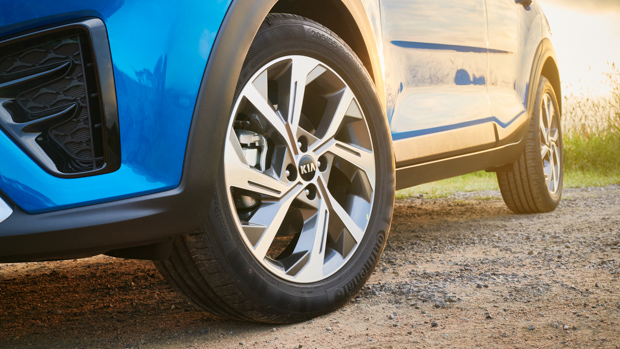
Body control on the Stonic GT-Line, which shares 17-inch wheels with the mid-tier Sport save for colouring, is enjoyable and fun. Continental ContiPremiumContact rubber is grippy, but the Stonic still shuffles about under load beneath you. It’s quite sporting.
Shame the steering ratio is a bit slow – with such little mass aboard (1,227kg), and more than competent tyres – the Stonic’s relatively lethargic turn-in feels mismatched to the capability on offer. The Toyota Yaris Cross is more fun to steer and punt around town.
But the Yaris Cross becomes frustratingly loud on a country road, which the Kia Stonic does not. Refinement is quite impressive, with road noise reasonably well insulated for a car of this sort.
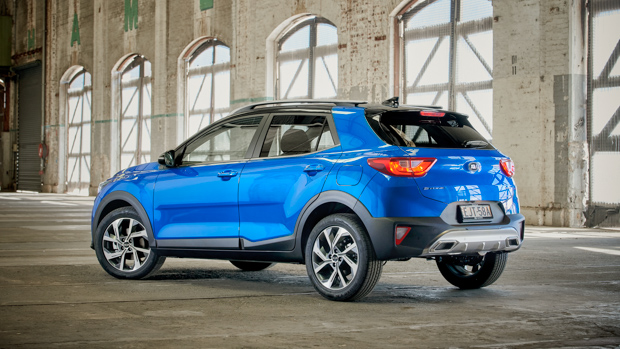
Mentioning the Toyota necessitates a discussion about the Kia Stonic’s safety rating. The decision to have the Rio hatchback’s 2017-vintage five-star ANCAP rating transferred across is a slightly awkward one, if only because rivals with much newer underpinnings have had to try much harder to score the full five stars.
The new Toyota Yaris Cross, for instance, needed junction AEB and a centre airbag to score five. Toyota wanted the rating, so they did the work, and incurred the additional costs that make up part of that car’s price. The Yaris Cross goes even further, with rear AEB.
The Stonic does not have those technologies, which were not compulsory for five stars in 2017. As such, it’s noticeably cheaper than the Yaris Cross. No junction AEB, no reversing AEB, no centre airbag. And yet … it wears five stars in ANCAP’s eyes.
As ever, the devil is in the detail.
The Stonic has been available in Europe for a few years – so while it’s a new addition to the Kia Australia portfolio, it isn’t an all-new car.
Looking at the crisp, well laid-out cabin, though, you’d be forgiven for thinking that it was. The drab interior of the Toyota Yaris Cross is blitzed by the Stonic, while the CX-3 looks downright dated.
Intelligently, Kia have located the Stonic’s standard eight-inch touchscreen front and centre. Unlike the CX-3, the screen isn’t too high, and unlike the Yaris Cross, it isn’t too dim. Quite the opposite. The screen is perfectly located, bright, high-resolution and highly intuitive.
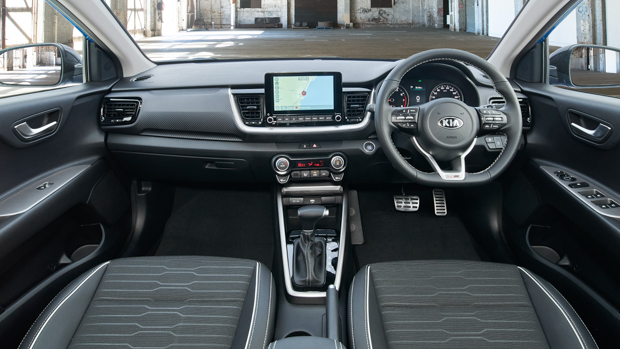
The GT-Line’s integrated navigation and DAB radio work well, and the speakers are reasonable. Plus, you have wired Apple CarPlay and Android Auto – though in a sign of the Stonic’s actual age, there are just two USB-A ports: one front, one rear. The Volkswagen T-Cross offers two per row.
Drivers will enjoy the Stonic GT-Line’s beautiful steering wheel, lifted more or less from the Stinger sports sedan. Perforated, flat-bottomed and contrast-stitched, it’s a lush luxury that feels thrice the price of this small SUV.
The seats, too, read from the song sheet of a European small SUV. They’re firm and supportive, manually adjustable, and, in the GT-Line, constructed from an elegant and summer-friendly mix of cloth centres and faux-leather outers.
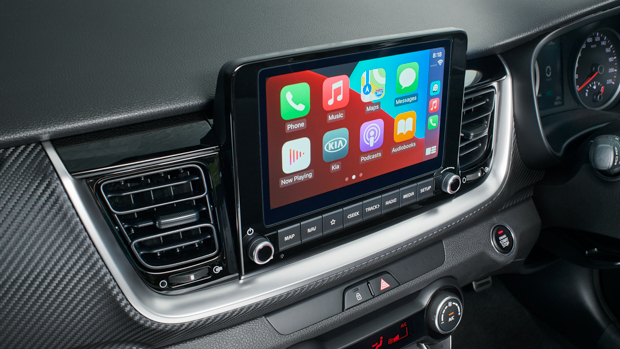
Marks come off for the entirely hard, scratchy dash trim applied equally to the doors – and the GT-Line’s veritable acre of fake carbon fibre ahead of the passenger isn’t all a bit much.
Ergonomically, we appreciate the inclusion of a centre armrest between the seats. This inclusion evadedToyota, where the Yaris Cross – even in top-trim Urban form – goes without one.
Practicality is good, too: big cupholders, a generous tray ahead of the stylish aviation-inspired automatic shifter, and unusually for a Korean car – 1.5-litre bottle holders in the doors. No wireless device charging, however.
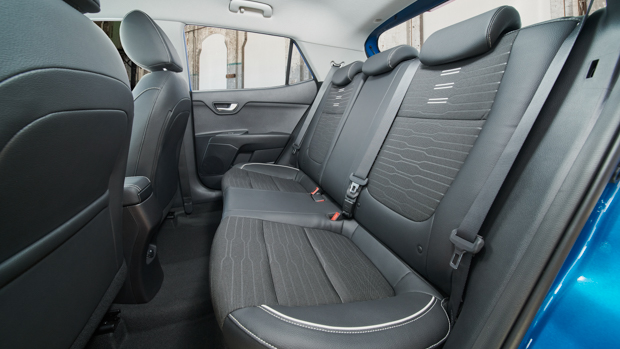
Move to the second row and Kia’s forthcoming Stonic ad campaign – featuring four adult friends in the car – makes sense. There’s truly enough space for this use, with six-footers ably catered for in the headroom, legroom and toe room departments.
You won’t find a centre armrest, nor rear air vents, but sadly, this is par for the course in the light SUV segment.
It’s the Stonic’s generous 352-litre boot where it convincingly beats out a Mazda CX-3, though: behind a light manual tailgate, the Stonic’s cargo area is smart and square. There’s a space saver spare tyre beneath the boot floor as well.
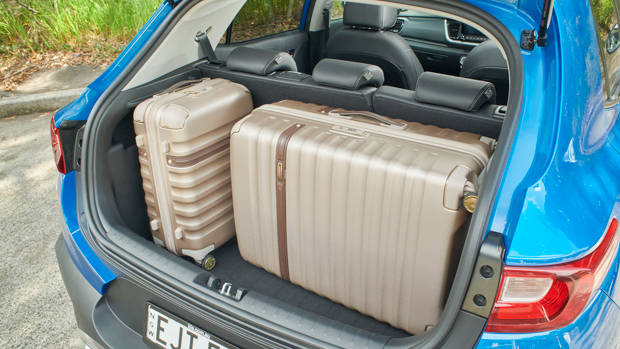
Like all Kias, the Stonic is covered by a seven year, unlimited kilometre warranty that is one of the best in the Australian car industry. The warranty is transferable to new owners.
You also get seven years of satellite navigation map updates, and a year of included roadside assistance.
That roadside assistance plan can be renewed for up to eight free years by servicing the Stonic on time through Kia’s seven year capped price servicing programme.
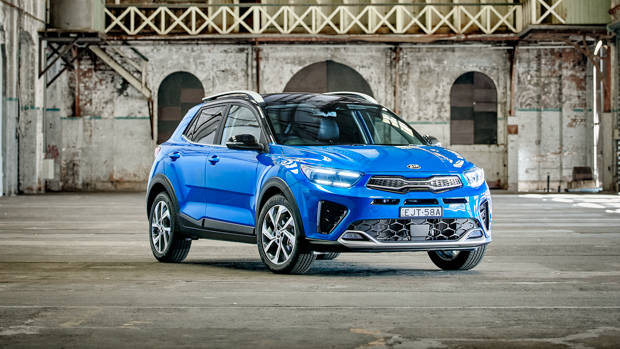
But while Kia caps the prices of Stonic services – that doesn’t mean they’re necessarily cheap. Kia have not yet published Stonic service costs, but given the fact this SUV is nearly identical to the Rio in a mechanical sense – the current Rio price list is a reasonable guide.
Servicing the one-litre turbo engine must be done every year or 10,000km – whichever comes first. Those intervals are shorter than the 1.4-litre four-cylinder, which can go 15,000km between annual services.
For the Rio, at least, the one-litre turbo costs $283, $484, $338, $704 and $319 to service at each of the first five maintenance stops. That’s an average of $1,105 over three years, or $2,128 over five years.
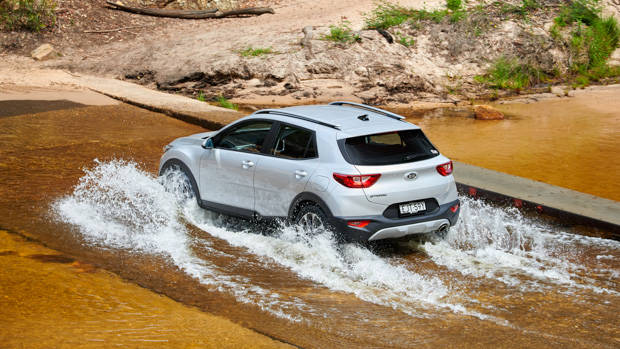
We’ll see if the Stonic deviates from this relatively costly servicing arrangement.
On the fuel consumption front, Kia claims the Stonic GT-Line turbo uses 5.4L/100km. In the real world, we managed 7.5L/100km without trying too hard. Like the Mazda CX-3, this is a fairly average result. The Toyota Yaris Cross Hybrid can get sub-4L/100km!
At least the Stonic will accept regular unleaded – premium octanes are not required.
There’s no doubt that the light SUV segment is a booming one – both in terms of sales, which rose nearly 15 percent across a tough 2020 – but also in the quality of the contenders.
The new Ford Puma, Skoda Kamiq, Toyota Yaris Cross and Volkswagen T-Cross, in particular, have challenged the dominant position of the Mazda CX-3. The Kia Stonic now joins that club of compact crossover fighters.
This group of small SUVs are all based on light hatchbacks. No shame in that: yet, in their transformation to cladded crossovers, most of these vehicles become considerably more expensive than the humble hatches they take their DNA from. The Stonic is hardly alone in doing so, but it’s worth pointing out.
That being said, the Kia Stonic is a small SUV that’s remarkably adept at coping with Australian road surfaces, both in town and outside it. The handling is sporty and firm but compliant, too. And the turbo engine is strong enough to cope – even if it’s a little pricey to maintain.
We’d consider the Stonic if shopping in this segment among the crowd of vehicles mentioned above – along with taking a critical eye to their slightly lower-riding hatchback siblings.
Variant tested GT LINE (TWO-TONE)
Key specs (as tested)
About Chasing cars
Chasing Cars reviews are 100% independent.
Because we are powered by Budget Direct Insurance, we don’t receive advertising or sales revenue from car manufacturers.
We’re truly independent – giving you Australia’s best car reviews.
The estimate provided does not take into account your personal circumstances but is intended to give a general indication of the cost of insurance, in order to obtain a complete quote, please visit www.budgetdirect.com.au. Estimate includes 15%^ online discount.
^Conditions Apply
Budget Direct Insurance arranged by Auto & General Services Pty Ltd ACN 003 617 909(AGS) AFSL 241 411, for and on behalf of the insurer, Auto & General Insurance Company Limited(ABN 42 111 586 353, AFSL 285 571).Because we don’t know your financial needs, we can’t advise you if this insurance will suit you. You should consider your needs and the Product Disclosure Statement before making a decision to buy insurance. Terms and conditions apply.
Indicative quote based on assumptions including postcode , 40 year old male with no offences, licence suspensions or claims in the last 5 years, a NCD Rating 1 and no younger drivers listed. White car, driven up to 10,000kms a year, unfinanced, with no modifications, factory options and/or non-standard accessories, private use only and garaged at night.
^Online Discounts Terms & Conditions
1. Discounts apply to the premium paid for a new Budget Direct Gold Comprehensive Car Insurance, Third Party Property Only or Third Party Property, Fire & Theft Insurance policy initiated online on or after 29 March 2017. Discounts do not apply to optional Roadside Assistance.
2. Discounts do not apply to any renewal offer of insurance.
3. Discounts only apply to the insurance portion of the premium. Discounts are applied before government charges, taxes, levies and fees, including instalment processing fees (as applicable). The full extent of discounts may therefore be impacted.
4. We reserve the right to change the offer without notice.